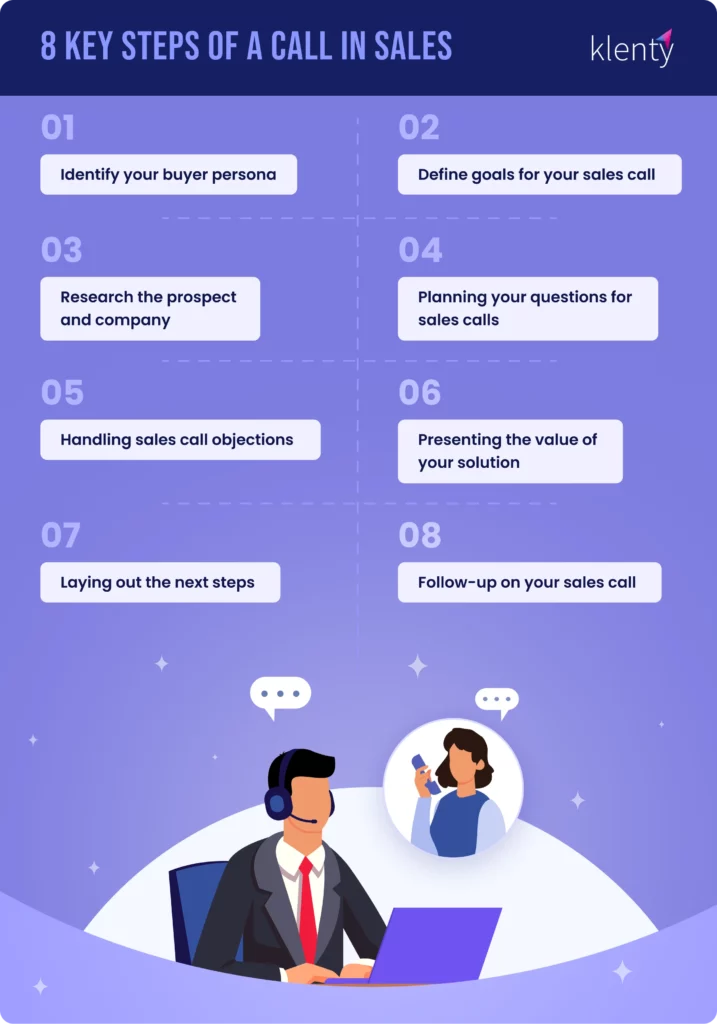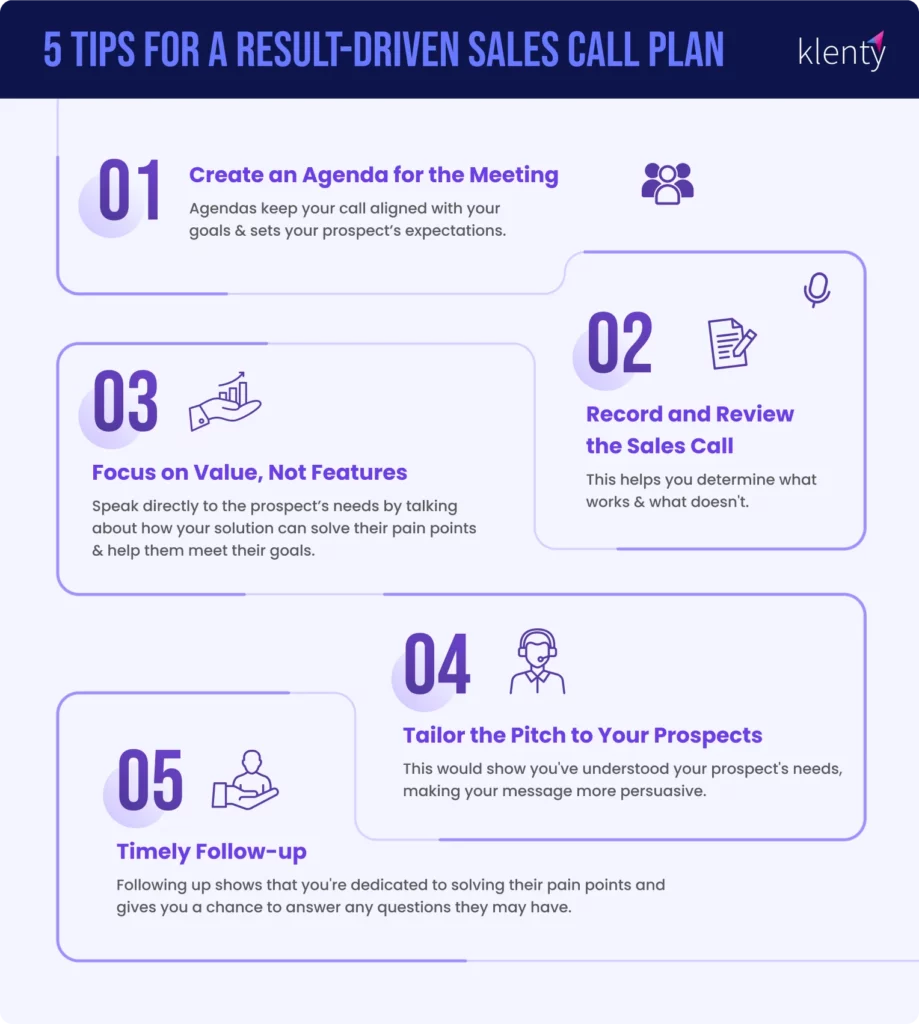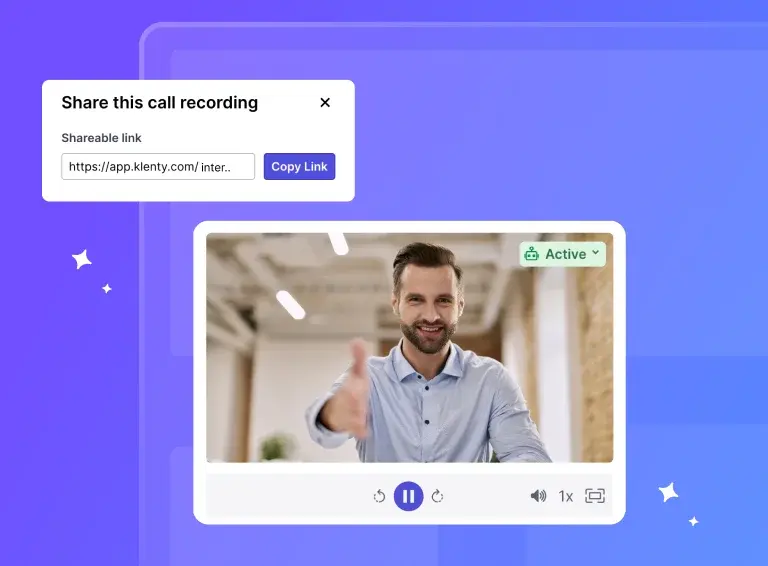Picture this: You're about to hop on a sales call. But you have no script, no strategy, and no clear direction. You're banking on winging it and hoping for the best.
Most sales reps confuse this grave mistake with flexibility. While you do need some level of flexibility to steer the sales call in a favorable direction, it's like going on an adventure without a map.
And let's be honest, when was the last time that actually led you to a treasure chest of closed deals?
This is why you need a well-crafted sales call plan. It's the secret weapon that can transform your sales calls from mere conversations into captivating journeys of persuasion and success.
What Is Sales Call Planning and Why Is It Important?
A sales call plan is like a cheat sheet for sales reps before they hop on a sales call. It outlines the prospect's details, their needs, and the objectives of the call.
Sales call planning helps you prepare for the conversation so you can think ahead and be prepared for any obstacles that might pop up. Plus, it lets you customize your approach to maximize the chances of having successful sales calls.
Think of it as your trusty roadmap to ensure your sales calls are well-informed and productive.
Before we jump into how to plan a sales call, let's understand its 3 main types:
Cold calls: Cold calling is when you reach out to prospects who’ve had no prior interaction with your company. They may not be expecting your call, so the conversation typically starts from scratch.
Warm calls: These calls involve reaching out to prospects who have shown some interest in your company or engaged with your content. This shared interest or interaction becomes a conversation starter. Warm calling help you nurture the prospect's interest further, understand their needs, and explore how your solution can help.
Sales appointment calls: A sales appointment call occurs after you've made initial contact with the prospect and gauged their interest. The purpose of this call is to schedule a specific time for a sales presentation or demo.
Now that you understand the different types of sales calls, let's dive into the heart of the matter—why do you even need pre call sales planning in the first place?
Here's the importance of sales call planning:
- Anticipating Plot Twists
Sales calls can be unpredictable. Prospects may throw objections or unexpected questions your way. A sales call planning process helps you play out different scenarios before the call so you can arm yourself with the right responses.
- Maximizing Efficiency
Time is valuable for both you and your prospect. A sales call planning helps you make the most of it. By having a clear agenda and objectives, you can keep the call focused and productive. This prevents the conversation from veering off track into irrelevant topics or going on for ages.
- Building Better Rapport
Sales call planning helps you connect with your prospects on a personal level, making them feel valued and understood. When you hop on a call armed with information about their business, industry, pain points, and even personal interests, it shows that you've done your homework.
Top-performing SDR Ashley Dees looks up interesting bits of information about the prospect and brings up specific information during the conversation. For example, if her prospect had shared an article on sales emails they wrote, she’d read it and talk about particular sections, like: ". I thought #5 was really cool, where you mentioned how important experimentation is in emails."
This instantly builds trust and rapport, setting a positive vibe for the conversation.
- Providing Value
sales planning involves thorough research. It helps you understand the pain points your prospect is experiencing and how your solution can help. With this information, you can tailor your pitch to address their specific needs and offer solutions that resonate with them.
But how do you create a sales call plan? We've got you covered.
8 Key Steps in Your Sales Call Plan
A well-crafted sales call plan is like your guiding star to having effective sales calls. Whether you're a seasoned sales pro or a newbie, our eight-step sales call checklist will be your secret formula for success. Let's dive right in.

1. Identify Your Buyer Persona
Your buyer persona is like the character sketch of your ideal customer. It is a detailed profile that defines the type of person or business that is most likely to benefit from your solution. It is a crucial step to understand your audience and connect with them on a personal level.
To identify the buyer persona in your sales call planning, start by analyzing your existing customers. What industry are they in? What challenges do they face? What goals are they trying to achieve? This will help you create a persona that mirrors your best customers.
Let's say you're selling software that helps small businesses manage their finances. Your analysis might reveal that your most satisfied customers are small business owners in the retail industry with 5 to 10 employees. They struggle with bookkeeping and want to reduce errors in their financial records.
Here's what your buyer persona could look like:
Name: Jessica, Small Business Owner
Industry: Retail
Company size: 5-10 employees
Challenges: Time-consuming bookkeeping, financial errors
Pain points: Inadequate time for essential financial tasks, no insight into cash flow and financial planning
Goals: Efficient financial management, cost savings
Buying behavior: Jessica combs through online resources, seeks advice from fellow business owners, and values real-world recommendations. She is looking for solutions that save time and reduce financial errors. Jessica is not an impulsive buyer. She prefers free trials or demos to test the solution's fit for her business. She values providers who guide her and understand her unique needs, making it about more than just the product—about the partnership.
The more detailed your buyer persona is, the more tailored your sales call script can be. This way, your conversation becomes less about generic sales pitches and more about providing value that resonates with your prospect.
2. Define Goals for Your Sales Call
Every successful journey begins with a destination in mind. Your sales call is no different. It's not just about picking up the phone and dialing a number; it's about having a clear purpose, a target you aim to hit.
Why is this important? Because it gives you a conversation purpose and direction, ensuring both you and the prospect are on the same page about what you aim to achieve.
- Do you want to identify the prospect's pain points?
- Do you wish to gather more information about their company or existing tools?
- Are you trying to up-sell or cross-sell a product?
- Are you looking to schedule a demo?
Having clear goals will help you structure your sales call effectively and highlight how your solution can solve their pain points. Your goals can also depend on where your prospect is in the buying journey. For example:
- If you're reaching out to a new prospect, your goal would be to schedule a discovery call to understand their needs and educate them about the solution.
- If you're calling a prospect who has shown interest in a solution, your goals might shift towards highlighting the value and benefits of a solution and addressing their objections.
- If the prospect is towards the end of the sales cycle, you might want to schedule a demo and negotiate terms.
3. Research the Prospect and Company
Without having proper research as a part of your sales call planning, you're essentially walking into the unknown. You wouldn't jump into a pool without checking if it's deep or shallow, right? Similarly, you wouldn't want to approach a prospect without fully grasping their business, challenges, and needs. Here's what you should look out for:
- Company background: What does the company do? What is their mission, values, and culture? This will help you understand how your solution can align with their objectives.
- Industry insights: Research their industry trends, challenges, and competitors to position your solution in a way that addresses industry-specific pain points.
- Decision-makers: Identify the key decision makers, their roles, responsibilities, and pain points to tailor your pitch appropriately.
- Recent news: Check for recent news or developments in the prospect's company, like launching a new product, raising a new round of funding, or receiving any awards. These nuggets of information can be great conversation starters.
- Mutual connections: Scour through your professional network to see if you have any mutual connections with the prospect. This can be an excellent way to establish trust and credibility.
4. Planning Your Questions for Sales Calls
Effective questioning is key to figuring out your prospect's pain points and goals. They help you control the flow and depth of the conversation. But remember, it's not about bombarding them with questions; it's about asking the right questions that lead to valuable insights. Here are the different types of questions you can throw their way:
- Open-ended questions: These encourage your prospect to provide detailed responses. For example, instead of asking a straightforward question like "Are you satisfied with your current solution?" you could ask, "What are the main challenges you face with your current solution?"
- Follow-up questions: Be prepared with follow-up questions to dig deeper into their responses. For example, if they mention a specific pain point, ask, "Can you give me an example of when this challenge caused a problem?"
- Listening questions: While asking the right questions is important, don't forget to listen actively. This shows you're paying attention and are genuinely interested in their opinion. For example, "Can you tell me more about how this impacted your team?"
- Objective-oriented questions: Align the questions with the goal of the call. If your aim is to schedule a demo, prepare questions that naturally lead to this outcome. For example, "Based on what you've shared, I believe a live demo of our solution could be beneficial. Would you be interested in scheduling one?"
5. Handling Sales Call Objections
Objections are natural in the sales process. They can be about anything—concerns about price, doubts about the product's suitability, competitors, etc. But with proper objection handling techniques, you can turn skepticism into trust and reluctance into enthusiasm.
How? By following the LURC framework: Listen, understand, respond, and confirm.
Let's understand this with an example.
Suppose you're selling subscription-based design software. The prospect objects that they already have free design tools available. Your response might follow these steps:
- Listen: Be attentive and let them express their concerns fully.
- Understand: "I understand that cost-effectiveness is important to you, and exploring free tools is a smart approach."
- Respond: "What sets our software apart is its extensive library of templates and advanced features. It can streamline your processes and save you time, boosting productivity and potentially generating more revenue for your projects."
- Confirm: "If you're ready to move ahead, I can schedule a demo so you can experience the tool yourself."
6. Presenting the Value of Your Solution
This step is the heart of your sales call, where you showcase how your solution can solve the prospect's pain points and fulfill their needs. It's not just about highlighting the features; it's about the transformation and benefits that it can bring to the prospect. Here's how you can work it out during your sales call planning:
- Use your research to tailor the pitch. Focus on features that directly solve the prospect's pain points.
- Highlight the benefits of your product instead of just listing its features. For example, "Our software automates repetitive tasks, saving you hours each week to focus on strategic initiatives."
- Share success stories where your solution has made a significant impact on similar clients. This builds credibility and demonstrates practical benefits. For example, "We recently worked with [competitor], who reported a 20% increase in project completion rate and a 30% improvement in client satisfaction after implementing our software."
7. Laying Out the Next Steps
As you wrap up the call, make sure to give your prospects some direction. Let them know the next steps so that both parties are on the same page and can move forward without any confusion. This way, everyone knows what to expect and how to navigate the sales journey smoothly.
You can do this in 4 steps:
- Mutual agreement: "Based on our discussion, it seems like our solution aligns well with your needs. I'd like to suggest our next steps and make sure they work for you. How does that sound?"
- Be specific: "Our next step would be to schedule a product demo to give you a firsthand look at how our software can [solve specific pain point]. Does [date and time] work for you? We'll send you a calendar invite shortly with all the details."
- Set expectations: "After the demo, we'll provide you with a personalized pricing quote based on your requirements. Once you receive that, we can schedule a follow-up call to discuss any questions or concerns you may have."
- Address concerns: "Before we proceed, is there anything else on your mind or any questions you'd like me to address?"
8. Follow-up on Your Sales Call
Many successful deals don't close on the first call. They require a series of well-timed follow-up actions.
In fact, 80% of sales need 5 follow-ups. However, 44% of sales professionals give up after just one.
So, include how you want to follow up after the call in your sales call planning. Based on the conversation, you can schedule another call, send a personalized email, or provide additional information.
This helps you to maintain open communication lines and make sure that both you and the prospect are on the same page as you move towards a decision. It also shows that you truly care about their needs and are fully dedicated to assisting them in finding the perfect solution. Remember: The fortune is often in the follow-up.
These 8 sales call planning steps will help you prepare, engage, and navigate the world of sales calls. But to really master it, you must follow some best practices that will supercharge your sales call plan and make it even more impactful and result-driven.
5 Tips for a Result-Driven Sales Call Plan
With the foundational steps in place, it's time to kick it up a notch and explore five killer sales call tips that will take your sales call planning game to the next level. These strategies are designed to amp up your approach, making each sales call not just productive but highly result-driven.

1. Create an Agenda for the Meeting
Agendas provide structure and purpose to your sales call. They ensure your calls remain focused, efficient, and aligned with your goals. Plus, sharing the agenda with your prospects in advance helps them understand what they can expect.
After defining the objectives of your call, outline key topics that you want to discuss. You can also assign time slots to each agenda to ensure you have sufficient time to address critical topics without rushing through them.
Share the agenda with the prospect before the call so they get a chance to review it, add any topics of interest, or clarify their expectations. When your prospect knows what to expect, they're more likely to engage in a focused and productive discussion, increasing the chances of a successful outcome.
2. Record and Review the Sales Call
Recording and reviewing your sales calls helps you determine what works and what doesn't. This helps you refine your strategy over time and transforms your sales calls from one-time interactions to learning opportunities.
Plus, recording your calls using a sales call recording software also makes it easier to train your team and help them perfect their pitches.
But make sure you obtain permission from the prospect to record the call.
3. Focus on Value, Not Features
Imagine you're shopping for a car. What would resonate more with you—the horsepower and engine type or the safety and fuel efficiency they bring?
When it comes to sales calls, the latter will be more likely to resonate with the prospects. Shifting your focus from a laundry list of product features to discussing how the product can genuinely benefit the prospect will speak directly to their needs. It will convey exactly how your solution can solve their pain points and make their life better.
"You are not successful unless your dream client believes that spending time with you was of greater benefit to them than spending that time with someone else, or working on something else," says sales expert Anthony Iannarino.
You can do this by:
- Understanding their pain points and highlighting how specific features can solve them.
- Asking open-ended questions to encourage prospects to share their pain points and goals.
- Sharing case settings or success stories that highlight the practical value your solution has provided to similar clients.
4. Tailor the Pitch to Your Prospects
Every prospect is unique, with distinct pain points, objectives, and challenges. A generic one-size-fits-all pitch may not resonate with them or address their concerns effectively.
Tailoring the sales pitch shows that you've taken the time to understand their unique needs, making your message more compelling and persuasive. It increases the chances of capturing their attention and securing their trust.
Leading sales strategist, Marc Wayshak explains: “Your prospect doesn’t care about you. What they care about is themselves. Is this conversation going to be worth my time? Will this solution solve a problem that I care about? If you can’t answer affirmatively to either or both of these questions, you’re in trouble. When the prospects see that the conversation is about them, they’ll be more engaged.”
5. Timely Follow-up
Following up with the prospect keeps the momentum of the sales process going. If you don't follow up promptly, there's a chance they might lose interest or forget important details.
Following up shows that you're dedicated to solving their pain points and gives you a chance to answer any extra questions or concerns they may have.
Plus, sometimes prospects just need a little nudge or reminder to keep moving forward. A well-timed follow-up can prevent missed opportunities and keep prospects from drifting away or choosing a competitor because of a lack of engagement.
How Can Sales Teams Plan Better?
A successful sales call is a blend of individual strategies and cohesive teamwork. By following these 8 steps, you can nail your sales call planning and ensure successful conversations that drive results. Also, don't forget to set an agenda, personalize your sales pitch, and focus on the value your solution brings to the table.
But how can you take your sales call planning the extra mile and ensure more closed deals?
With Call IQ by Klenty, you can harvest valuable insights from every call, based on which you can plan your future sales calls and close more deals.
Call IQ records, transcribes, and analyzes all your sales calls or meetings (both audio and video calls). One of its key features is generating 4 types of AI-powered summaries. Here’s how each of these can help your sales call planning:
- Sentiment presents a break-up of all positive and negative sentiments in the call, which helps you track which direction the call is headed and plan accordingly.
- Questions Asked collects all questions asked during the call. Reps can analyze common objections posed and learn how to handle them tactfully.
- Spotlight Summaries covers the important moments of the call and gives a minute-by-minute breakdown. Using this, you can easily review what went right and what went wrong in your previous calls.
- Action Items enables you to always follow up with context and on time with prospects after the call.
Not just this: Call IQ provides the talk time metric of each call—how much you spoke vs. how much the prospect spoke—so that you can plan on having a quality back-and-forth conversation with your prospects in your sales calls.
Book a demo today and boost your sales call planning with Call IQ!
Resources You'll Love:
FAQs
How do you structure a sales phone call?
- Research the prospect and set clear goals for the call.
- User mutual connection or shared interest to greet them and build rapport.
- Outline the agenda of the call.
- Ask open-ended questions and actively listen to their needs.
- Highlight your solution's benefits and address their objections.
- Ask for their commitment or set up the next steps.
- Summarize key points of the conversation and outline the next steps.
- Thank them for their time and ask if they have any concerns.
- Promptly send a follow-up email outlining the next steps.
How do you make sales calls more effective?
- Create an agenda for the meeting
- Record and review the sales call
- Focus on value, not features
- Tailor the pitch to your prospects
- Follow up with them on time





